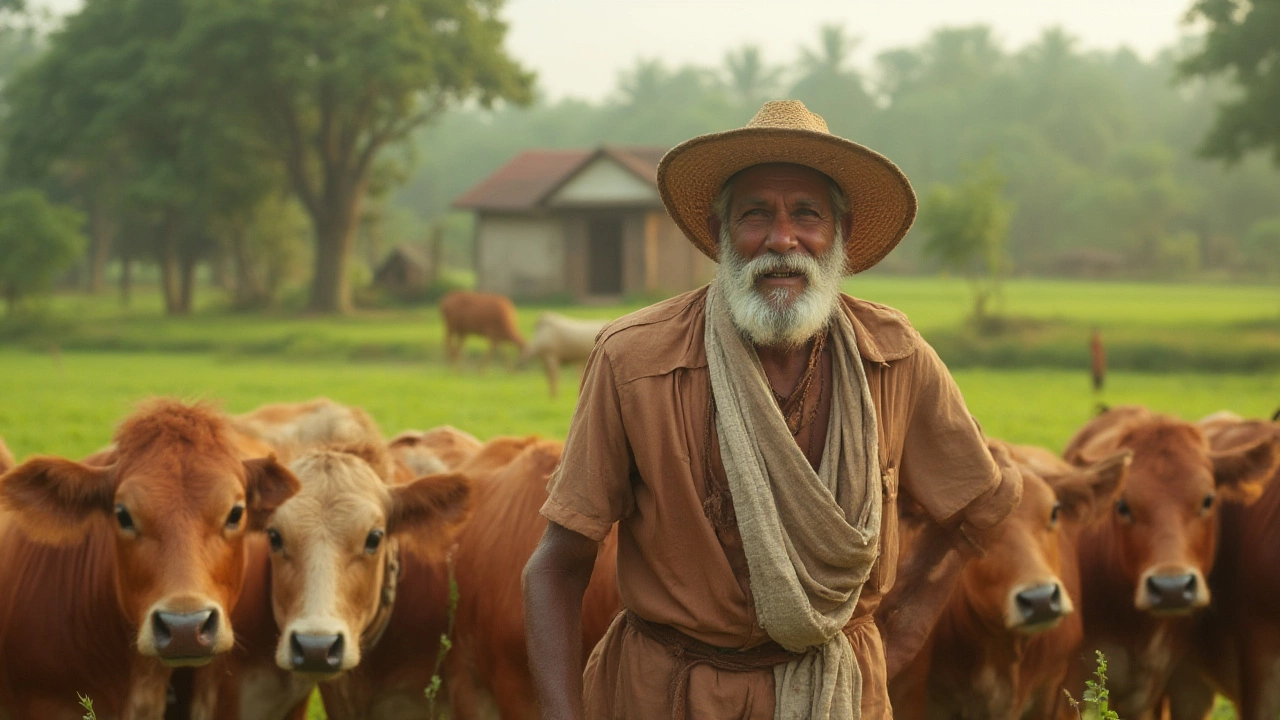Ever notice that everyone has an opinion on how many cows you can fit on a patch of land? Ask ten old-timers at the local feed store and you'll get ten different answers, plus a few side-eyes if you mention anything about "stocking rates." The truth is, 20 acres sounds like a lot, but when it comes to feeding hungry cows, it’s easy to bite off more than your pasture can chew. Overcrowd them, and you’ll turn good grass into a mud pit before you know it. Thin out your herd too much, and you’re leaving money—and prime steak—on the table. One thing’s for sure: there’s no magic number. But with a little math, some real-world examples, and a dash of honesty about your land, you can figure out the sweet spot for raising cows on 20 acres without grinding your field into a dustbowl.
Understanding Cattle Stocking Rates on 20 Acres
First up, there’s a term ranchers like to throw around—the “stocking rate.” Basically, this means how many cows can live on a certain amount of land and still leave enough grass for regrowth year after year. But here’s where things get complicated. Stocking rates depend on all sorts of variables: the quality of your pasture, annual rainfall, the breed and size of the cows, how long they’ll be in the field each year, and even how many calves you add to the mix. If your acres are lush with thick Bermudagrass and you get plenty of steady rain, you’re way ahead of the game. If your land is patchy and summers are bone-dry, you’ll have to cut back. The old rule of thumb in much of the United States is called the “animal unit,” which is one mature 1,000-pound cow (plus a calf up to 6 months old) grazing year-round. A classic estimate is that it takes 2 acres to support one animal unit for 12 months. With twenty acres, you might think you could run 10 cows. But—and it’s a big but—that’s on land with ideal grass and weather.
Here’s what it looks like when you break it down with some real U.S. statistics. According to the USDA, average pasture yields in the Midwest are about 3,000 to 4,000 lbs. of dry forage per acre per year. Most cows need about 25 to 30 lbs. of forage per day—that's over 10,000 lbs. per year. Plus, you can’t let cows graze down to the dirt. You want to leave at least 3 to 4 inches of grass if you want the pasture to bounce back. So even in states with good rainfall, most people end up with a real, practical stocking rate closer to 1 cow per 2.5 or even 3 acres unless they use intense management, rotating paddocks to let some grass rest. In drier or more marginal land (think Texas Hill Country or parts of Oklahoma), the ratio jumps to 1 cow per 5 acres or more. If you try to push more cows than the grass can handle, expect to fill in the gaps with expensive hay—and risk turning your land to hardpan.
Breed type counts, too. Aberdeen Angus or Herefords are big eaters, while smaller heritage breeds or Dexter cattle can get by on a little less. Still, a cow’s stomach isn’t shrinking just because your land looks good on Google Maps. Throw calves and bulls into the mix, and your math has to adapt all over again.
| Pasture Type | Avg. Rainfall (inches) | Approx. Acres per Cow (annual, no supplement) | Suggested Stocking Rate for 20 Acres |
|---|---|---|---|
| Lush Improved Pasture (Midwest or SE) | 35-50 | 2-2.5 | 8-10 cows |
| Average Pasture (mixed grass, moderate rainfall) | 25-35 | 3-4 | 5-6 cows |
| Dry/Native Range (Great Plains, Tex/Oklahoma) | 10-20 | 5-10 | 2-4 cows |
Here’s something people overlook: cows eat year-round, but grass doesn’t always grow year-round. Winter, drought, or any disaster—your pasture may need a break, and you’ll need backup hay or managed rest periods, which can cut your stocking expectations. If you plan on continuous grazing without supplements, stay on the conservative end of the range.

Practical Tips for Managing 20 Acres with Cattle
Now, let’s get down to what actually works. The smartest cattle raisers manage their land as obsessively as their animals. If you want to squeeze the most out of 20 acres, rotational grazing is your best friend. Don’t just dump the cows in and hope for green grass year after year. Instead, split your fields into 4, 6, or even 8 paddocks and move your herd every few days (or weeks), so the grass gets time to recover. Studies from Mississippi State and other ag colleges show pasture yield and soil health both improve with this system. You’re mimicking how bison or deer would eat one field, then roam off and let it regrow. A little planning with electric fencing and some simple water setups go a long way.
Another key is soil health. Regular soil tests let you know if you need to add lime or fertilizer, or if you’re missing mineral nutrients. Bad soil means slow grass. Good soil means the cows can graze longer without hammering it down to dirt. Overseeding with clover or ryegrass in early spring can stretch the grazing period. If you can get an extra month or two of good grass, you cut how much hay you need. And every bale of hay you don’t have to buy feels like a little victory on your bottom line.
Water is also huge. Cows need about 10-15 gallons per head per day in summer. If your water comes from a pond, creek, or trough, keep a close watch—when 10 cows belly up to one small tank, it empties faster than you’d think. A lot of newbies underestimate daily water needs and end up running hoses all summer.
Don’t forget, feed and mineral supplements may be necessary. Even the best pasture won’t supply every trace nutrient. Salt and mineral blocks help prevent health issues you won’t notice until you’ve got big vet bills. Keep a close eye on forage during drought, winter, or after heavy grazing—if you see bare spots, you’re pushing too many cows. When grass production dips, have good hay—preferably your own—stacked up before the cows start losing weight.
Predators and fencing are the headaches nobody advertises. Coyotes, stray dogs, and even bigger wildlife can bother calves. Good tight fencing (electric or barbed) is non-negotiable, not just to keep cows in, but to keep trouble out. Walk your fences monthly. It sounds like a chore, but a stray cow is harder to explain to the neighbors (and your insurance agent) than an afternoon spent mending wire.
- Plan for bad years—drought or wet springs can cut usable pasture by 30% or more. Don’t set your stocking rate for a perfect year; set it for an average year.
- Keep a grazing notebook or use free apps to track how many days each paddock gets grazed and rested. You’ll spot problems before they get expensive.
- Test your well or pond for water quality if it’s the main source. Cattle can be picky, and contaminated water can mean lost weight or worse.
- If you’re tight on space, raise calves to weaning and then sell, instead of trying to overwinter too many cows and calving on muddy ground.
- Know your market: if beef prices spike, you may want to rotate stock or pasture more intensively. If prices crash, focus on minimizing input costs and protecting your land.

Real-World Examples and Stories from 20-Acre Ranches
I’ve seen 20-acre setups go both ways: some look like a green paradise where cows thrive year after year, while others are worn out by late summer, with cows picking among weeds. What makes the difference? One neighbor near Springfield, Missouri runs six whiteface cows and calves on 19 fenced acres, with a small pond and a strip of woodland for shade. He splits his ground into five paddocks and moves his herd every 10 days. His hay bill is less than half of what he paid in his first year before he rotated. Another rancher outside Waco, Texas, found three cows and their calves was plenty on his more drought-prone twenty acres, confirming what the local extension agent advised him: push the land too hard and recovery gets expensive, fast.
Years back, a retired couple bought 20 acres outside Tulsa. Their land looked good in spring, but by the third year, after running 10 black Angus cows without much rotation, 15 acres had turned weedy and two springs had gone dry. They tried to recover by reducing their herd to six and investing in overseeding. After a year of giving two paddocks a complete season to rest, the pasture slowly bounced back. Their big lesson? You can always add another cow, but if you ruin pasture, it can take years to fix—and cost far more than you’d ever make off an extra calf.
Statistics also back up these stories. The Noble Research Institute tracked pasture projects and found that, in most southern states, 4-6 cows plus their calves per 20 acres is the sweet spot for longevity and profit, assuming average rainfall, moderate fertility, and basic rotational grazing. Some folks have gone as high as 8-10 cows, but only by intensively managing both grass and water, and with backup hay for bad years. Not one has gone above that mark for more than a year or two without hitting trouble.
If you’re thinking of going all-in, your timeline matters. If you want to finish steers for the freezer, you’ll get a bit less turnover on your pastures for a year or two while the beef fattens. Folks running only cows and calves for weaning can stretch the land a bit further. There’s also a social aspect. Some folks partner with neighbors to share equipment, seed, or even grazing space if the weather gets tough. If you’re serious about growing your herd, it pays to watch how the most successful small-farm ranchers treat their 20 acres like precious gold, not just empty space.
At the end of the day, the best number of cows for 20 acres is the one that lets you sleep at night—not the highest number you can push when the weather’s perfect. Risk a little understocking and you’ll save on hay, keep your pasture healthy, and have a real shot at profit. The bad years will come, but a careful, observant cattle owner always comes out ahead over time.
If you want the TL;DR: For most people, the real-world answer is 4-8 cows for 20 acres, with the difference made by climate, pasture health, water, and how hard you’re willing to work. Push it any further, and you’re rolling the dice with your land and your wallet.





